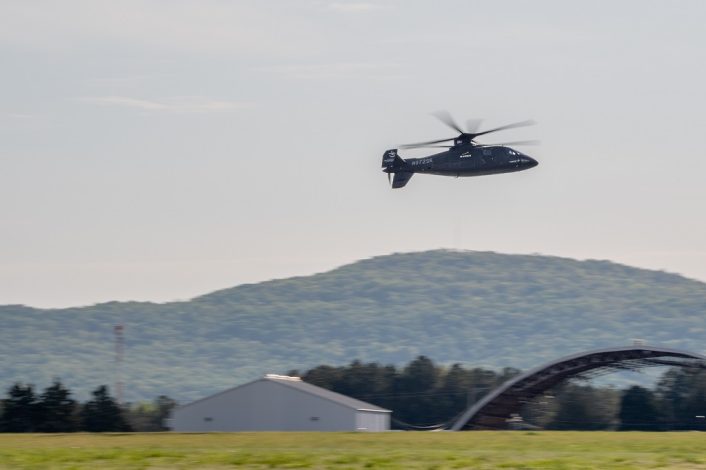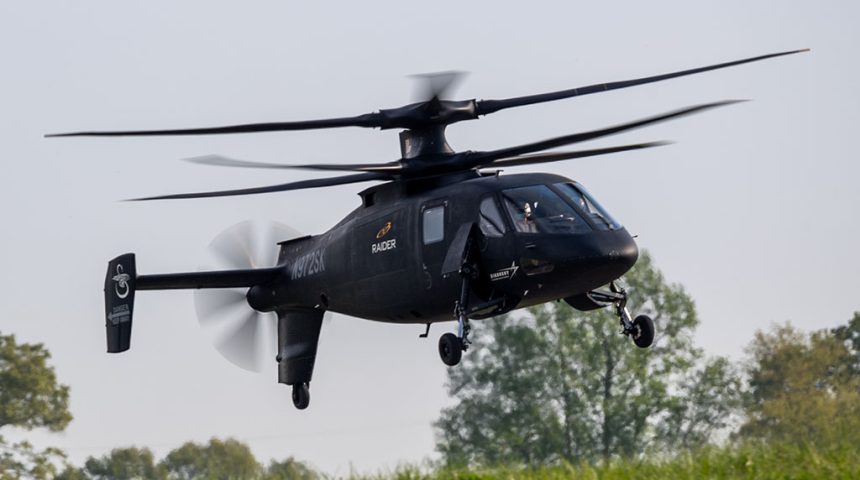The demonstrations were meant to show the S-97 Raider’s agility and the program’s status to the U.S. Army personnel working on the Future Vertical Lift program.
Sikorsky demonstrated the S-97 Raider, the company’s development aircraft for the Future Attack Reconnaissance Aircraft (FARA) program, to the U.S. Army personnel at Redstone Arsenal in Huntsville (Alabama) on April 13 and 15, 2021. Sikorsky’s test pilots Christiaan Corry and Bill Fell flew the Raider in routines “that highlighted both low-level helicopter maneuverability and the high-speed capability”.
“Flying RAIDER continues to amaze me,” said Corry, a former U.S. Marine with more than 4,500 flight hours in 25 types of aircraft including the CH-53E, CH-53K and others. “The combination of the coaxial rotors and the propulsor are really the enablers for this transformational technology. As we demonstrated today, in low-speed flight we are as capable as a conventional helicopter, but when we engage the prop, we are able to operate in a whole new way – it’s much more like flying an airplane.”
These demonstrations at Redstone Arsenal follow the first flight of the U.S. Army experimental test pilot Charlie Packard, the Army’s test director for Sikorsky’s FARA, on the S-97 last year, accompanied by Corry. Packard’s flight last year and this week’s demonstration contribute to the establishment of the combined test team that will work on the prototypes for the competitive program.
“Since the first Black Hawk took to the skies in the 1970s, to when our teams broke helicopter speed records with X2 Technology in 2010, we have been working with our Army partners to develop and deliver low-risk, transformational, affordable and sustainable aircraft to support the warfighters’ missions,” said Sikorsky President Paul Lemmo, who was at Redstone this week. “This is the first of what we believe will be many times our X2 Future Vertical Lift aircraft will fly at Redstone.”
As mentioned in the press release, the S-97 Raider is the only representative FARA aircraft flying today and it’s used as a risk reduction measure for Sikorsky’s FARA proposal, the Raider X. The compound helicopter is based on the company’s technology first developed for the X2 experimental helicopter, the same used also for the Defiant X, Sikorsky’s submission for the Future Long-Range Assault Aircraft (FLRAA) competition.

The other finalist submission in the FARA program is the Bell 360 Invictus, which however doesn’t have a developmental aircraft currently flying like the S-97. Last month, however, Bell said that their FARA team has completed 30% of the Invictus prototype since the construction of the helicopter started in October. According to their statements, the works are on schedule and system integration on the airframe will begin soon.
While at Redstone, Sikorsky’s representatives discussed the company’s “approach to mission and weapons systems integration, manufacturing and sustainment” with the Army. One of the features mentioned is the quantity of maintenance data available to commanders to accurately assess the health state of the weapon systems as well as the ability to self-diagnose maintenance and predict aircraft availability, with the goal of increasing the operational readiness and availability and reducing life cycle costs associated with the Raider X.
The tool that allows this is Sikorsky’s Fleet Decision Tool, which is said to aggregate data from individual aircraft based on operational requirements, aircraft health assessment and maintenance flow to ensure they are optimizing readiness and aircraft availability across the entire fleet. A similar concept can be found also in Lockheed Martin’s ALIS (Autonomic Logistics Information System) for the F-35. This is not a mere coincidence, as Lockheed Martin is Sikorsky’s parent company.
Kevin Mangum, Lockheed Martin Vice President for Army programs added: “This means that I, as a commander, could look at my aircraft battalion and understand the health of each one of the aircraft and prioritize the right aircraft for the next mission. This positions us to meet the Army’s Maintenance-Free Operating Periods in which Raider X and Defiant X helicopters could operate without the need for service for an extended period of time.”
The demonstrations of the S-97 Raider at Redstone come few days after the U.S. Army’s Requirements Oversight Council has approved the FARA requirements after a review that had to determine if industry designs are ready for a fly-off at the end of 2022. The resulting Abbreviated Capabilities Development Document (A-CDD) that validated the designs follows the Final Design and Risk Review (FD&RR) made in December 2020.
“What we saw back on the final designs from industry were impressive to the government team. Industry really did more. I think that gets into talent management, to use an Army term, because they had a cheat rep with [Joint Multi-Role Technology Demonstration],” said Maj. Gen. Wally Rugen, director of the U.S. Army Future Vertical Lift Cross-Functional Team. “The industry teams have really been better than we thought they would be on this design work.”









